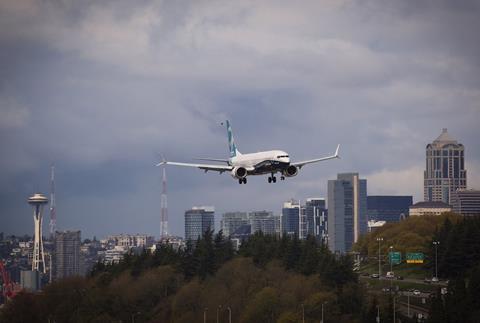US National Transportation Safety Board (NTSB) chair Jennifer Homendy blasted the Federal Aviation Administration for dragging its feet on a rule change that she says will significantly increase commercial aviation safety in the USA, and assist with investigations.
Speaking at a media conference in Portland, Oregon on 7 January, Homendy criticised the US regulator for its lax standards for aircraft cockpit voice recorders (CVR). She is in Portland leading an NTSB investigation team probing the accident in which an Alaska Airlines Boeing 737 Max 9 lost an emergency exit row door plug while in flight on 5 January.
As the investigation gets underway, she says the data on the accident aircraft’s CVR, which had been transported to an NTSB lab earlier in the day, had been deleted before experts could get to it. That leaves them with no documentation of communications on the flight deck in the moments before the event unfolded.
“The cockpit voice recorder was completely overwritten,” Homendy says. “There is nothing on the cockpit voice recorder.”

Currently, the FAA requires that cockpit voice recorders store the last two hours of information, after which the device overwrites the oldest data to maintain a rolling 2h recording. The NTSB has long urged the FAA to extend the requirement to 25h – consistent with other regions.
“Since 2018 we have done 10 investigations where the CVR was overwritten, four of those were recent runway incursions,” she says.
She cites an incident in 2018 where a disaster was narrowly averted when an Air Canada jet on approach to San Francisco International airport lined up with a taxiway, instead of the runway to which it was cleared.
“On that taxiway were four airplanes with about 1,000 people. The Air Canada plane came within 60ft [of the other aircraft] before it began to perform a go-around, and the CVR was overwritten,” making the investigation of that event more complicated.
More recently, several close calls and severe runway incursions in late 2022 and early 2023 involving large commercial aircraft prompted the FAA to hold a safety summit in March last year to address issues that could have led to those incidents - and which could be a further safety risk in the future.
As a result of the summit, the FAA committed to pursue the 25h recording requirement, but only for newly manufactured aircraft. On 1 December the US regulator proposed the new rule, and the public has 60 days to comment. The new rule would align with regulations set by the International Civil Aviation Organization and European Union Aviation Safety Agency, which went into effect in 2021.
But the NTSB’s Homendy now says that’s inadequate, and implored the FAA to extend that proposed requirement to aircraft currently in operation.
“I’m calling on the FAA to change the rulemaking,” Homendy says. “We are calling for 25-hour CVRs in not just new aircraft but for retrofitting aircraft.”
The airframes currently flying, like the Alaska aircraft, could be in operation for several more decades, and making the change to in-service airframes is relatively easy and relatively inexpensive.
“You can easily install a different cockpit voice recorder and increase the time from two hours to 25 hours,” she adds.
In its December proposal, the FAA estimated the cost per aircraft for the upgrade to be “from near parity to an upper bound of approximately $4,500”.
“If the FAA won’t do it, we hope Congress will take action in the FAA Reauthorization Bill to ensure that it does,” Homendy says.
“I cannot emphasise enough how important that is for safety.”
















































